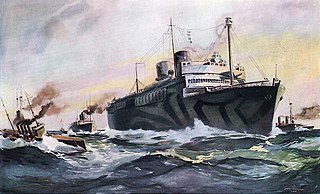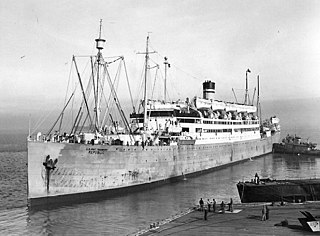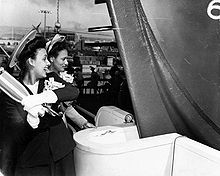
USS Comfort (AH-3) was a hospital ship for the United States Navy in World War I. She was the sister ship of USS Mercy (AH-4) but the two ships were not of a ship class. Comfort was known as SS Havana in passenger service for the Ward Line, and as USAT Havana in United States Army service before her Navy service. Her name was restored to Havana in 1927, and she was renamed SS Yucatán in 1935, and SS Agwileon in 1941. In World War II, she was known as USAT Agwileon and USAHS Shamrock in service for the United States Army.

The USS Albireo (AK-90) was a Crater-class cargo ship in the service of the US Navy in World War II and crewed by the US Coast Guard. She was the only ship of the Navy to have borne this name. She is named after Albireo, a star in the constellation of Cygnus.

USS General A. W. Greely (AP-141) was a General G. O. Squier-class transport ship named for U.S. Army general Adolphus Greely. She was transferred to the U.S. Army as USAT General A. W. Greeley in 1946. On 1 March 1950 she was transferred to the Military Sea Transportation Service (MSTS) as USNS General A. W. Greely (T-AP-141). She was later sold and converted to a container ship and operated under several names before being scrapped in 1986.
SS Henry R. Schoolcraft was a Liberty ship built in the United States during World War II.

USS Siboney (ID-2999) was a United States Navy troopship in World War I. She was the sister ship of USS Orizaba (ID-1536). Launched as SS Oriente, she was soon renamed after Siboney, Cuba, a landing site of United States forces during the Spanish–American War. After her navy service ended, she was SS Siboney for the New York & Cuba Mail Steamship Co.. The ship was operated under charter by American Export Lines beginning in late 1940. During World War II she served the U.S. Army as transport USAT Siboney and as hospital ship USAHS Charles A. Stafford.

SS Samuel Huntington was an American liberty ship during World War II. She was the 248th liberty ship authorized by the United States Maritime Commission and was named in honor of Samuel Huntington, a Founding Father and signer of the American Declaration of Independence. SS Samuel Huntington was launched in 1942 and sailed to ports in the Pacific, South America, Africa, and the United Kingdom. She was one of a select group of liberty ships that were outfitted to carry a limited number of either troops or prisoners of war. As part of a convoy to resupply the Allied troops at Anzio, she sank after a successful German bomb attack in January 1944.

USS Bridgeport (AD-10/ID-3009) was a destroyer tender in the United States Navy during World War I and the years after. She was a twin-screw, steel-hulled passenger and cargo steamship built in 1901 at Vegesack, Germany as SS Breslau of the North German Lloyd line. Breslau was one of the seven ships of the Köln class of ships built for the Bremen to Baltimore and Galveston route.

USS Tomich (DE-242) was an Edsall-class destroyer escort in service with the United States Navy from 1943 to 1946. She was scrapped in 1974.
USS PC-817 was a PC-461-class submarine chaser built for the United States Navy during World War II. She was later renamed Welch (PC-817) but never saw active service under that name.

USS General O. H. Ernst (AP-133) was a General G. O. Squier-class transport ship for the U.S. Navy in World War II. She was named in honor of U.S. Army general Oswald Herbert Ernst. She was decommissioned in 1946 and transferred to the Army Transport Service as USAT General O. H. Ernst. She was sold privately in 1964 and renamed SS Calmar, and was scrapped in 1980.

USS General R. L. Howze (AP-134) was a General G. O. Squier-class transport ship for the U.S. Navy in World War II. The ship was crewed by the U.S. Coast Guard throughout the war. She was named in honor of U.S. Army general Robert Lee Howze. She was transferred to the U.S. Army as USAT General R. L. Howze in 1946. On 1 March 1950 she was transferred to the Military Sea Transportation Service (MSTS) as USNS General R. L. Howze (T-AP-134). She was later sold for commercial operation under the name SS Austral Glen, before being scrapped in 1980.

USAHS Blanche F. Sigman was a United States Army hospital ship during World War II. The ship was completed in April 1943 as Liberty ship SS Stanford White. When selected for conversion to a hospital ship, she was originally assigned the name USAHS Poppy, but never operated under that name. After being decommissioned as a hospital ship, she became U.S. Army transport USAT Blanche F. Sigman.
SS Andrew Furuseth was a Liberty ship built for the United States Maritime Commission during World War II. The ship was named in honor of American merchant seaman and labor organizer Andrew Furuseth. The ship was assigned by the War Shipping Administration to Matson Navigation Company who operated it throughout the war in the Atlantic and Mediterranean. Andrew Furuseth was one of 220 Liberty ships converted to carry a limited number of troops or prisoners of war.

USS Republic (AP-33) was a troop transport that served with the US Navy during World War II. In World War I she served with the Navy as USS President Grant (ID-3014) before being turned over to the Army and named Republic. The ship was renamed the President Buchanan in 1921 before reverting to Republic in 1924.

The Type C4-class ship were the largest cargo ships built by the United States Maritime Commission (MARCOM) during World War II. The design was originally developed for the American-Hawaiian Lines in 1941, but in late 1941 the plans were taken over by the MARCOM.
USS Buckthorn (YN-9/AN-14) was an Aloe-class net laying ship built for the United States Navy during World War II. Originally ordered as USS Dogwood (YN-3), she was renamed and renumbered to Buckthorn (YN-9) before construction began in December 1940. She was launched in March 1941, and completed in September 1941. Placed in service at that time without being commissioned, she was commissioned in December 1942, and decommissioned in August 1947. She was placed in reserve in 1947 and scrapped in 1976.

SS Zebulon Vance was a Liberty ship built in the United States during World War II. She was named after Zebulon Vance, the two time Governor of North Carolina, lawyer, and Confederate Army officer.
SS St. Olaf was a Liberty ship built in the United States during World War II. She was named after St. Olaf, the King of Norway from 1015 to 1028. He was posthumously given the title Rex Perpetuus Norvegiae and canonised at Nidaros, by Bishop Grimkell, one year after his death in the Battle of Stiklestad.

MV Saturnia was an Italian ocean liner named after Saturnia, Tuscany, the first of two sister ships built in Trieste for Cosulich Soc. Triestina di Nav. of Trieste and launched in 1925. Sister ship MS Vulcania was launched the next year. Saturnia served into World War II for Italy and upon the Italian armistice with the Allies was delivered to the U.S. War Shipping Administration (WSA) in an arrangement made between Italy and Admiral Cunningham of the Royal Navy, approved by General Eisenhower.



















